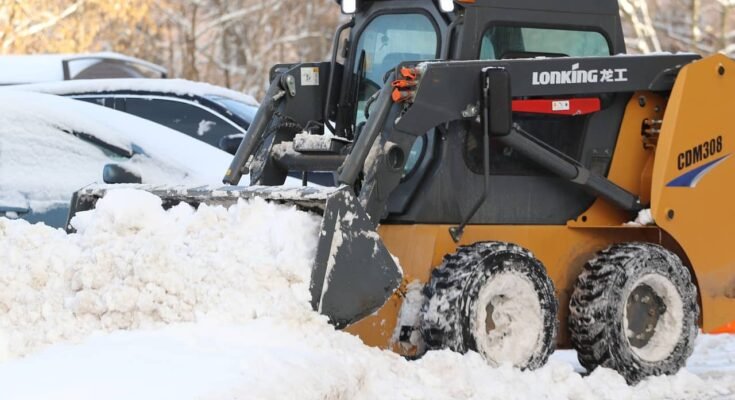Metal tracks stand out as a critical component for skid steer loaders that can significantly enhance the machine’s performance, especially on rugged terrain.
This article dives into everything you need to know about metal tracks for skid steer loaders, their benefits, types, installation tips, maintenance, and answers to common questions.
Critical Benefits of Metal Tracks for Skid Steer
Durability and Longevity
Metal tracks offer unmatched durability, especially when compared to rubber tracks. They are designed to withstand high-stress environments, providing longevity in rough terrain and challenging conditions.
Enhanced Traction on Rough Terrains
With metal tracks, skid steers gain superior traction on uneven surfaces like mud, rocks, and gravel. This enhances stability and reduces slippage, making operations safer and more efficient.
Higher Load Capacity
Metal tracks distribute weight more evenly than rubber tyres, allowing skid steers to handle heavier loads with reduced ground pressure. This capability makes metal tracks essential for heavy-duty tasks.
Reduced Wear on Skid Steer Tires
Using metal tracks significantly reduces tyre wear and tear, as the tracks take on much direct contact with the ground. This, in turn, leads to reduced maintenance costs over time.
Cost-Effectiveness Over Time
Despite the initial cost, metal tracks are more cost-effective in the long run due to their durability and reduced need for frequent replacements, making them a valuable investment.
Metal Tracks vs. Rubber Tracks: Which is Better?
Choosing between metal and rubber tracks depends on the specific use case. Here’s a breakdown to help you make an informed decision:
Metal Tracks
- Pros: Durability, high traction, better load distribution.
- Cons: Higher upfront cost, not ideal for delicate surfaces.
Rubber Tracks
- Pros: Lightweight, gentle on fragile surfaces, more affordable.
- Cons: Less durable, less effective on rugged terrain.
Types of Metal Tracks for Skid Steer
Bolt-On Metal Tracks
These tracks are designed to attach securely to the skid steer’s tyres, providing increased traction without requiring significant modifications. Metal Tracks for Skid Steer.
Over-the-Tire Metal Tracks
These tracks fit directly over the skid steer’s tyres, making installation and removal easy. They’re ideal for operators who switch between terrains regularly.
Customizable Metal Tracks Options
Customized metal tracks can be designed to fit specific machine types and terrains for unique operational requirements, offering tailored performance.
How to Choose the Right Metal Tracks for Your Skid Steer
Compatibility and Size
Choose tracks compatible with your skid steer’s specifications. Always check size requirements to ensure a secure fit. Metal Tracks for Skid Steer.
Load and Terrain Analysis
Consider the type of terrain and the loads you’ll be handling. Heavy-duty tracks are best for rough terrains, while lighter metal tracks can work well on mixed surfaces.
Cost and Budget Factors
While metal tracks may seem pricey initially, they offer a worthwhile return on investment due to their durability.
Installation Tips for Metal Tracks on a Skid Steer
5.1 Preparing Your Skid Steer for Metal Tracks Installation
Before installation, ensure your skid steer is on a level surface. Check for undercarriage and tyre damage, as metal tracks need a stable base. Metal Tracks for Skid Steer.
5.2 Step-by-Step Installation Guide
- Align Tracks: Position the metal tracks near the tyres and align them for attachment.
- Secure Tracks: Follow the manufacturer’s guidelines to securely attach or bolt the tracks.
- Tighten Properly: Ensure all bolts or clamps are securely tightened for maximum stability.
- Test Movement: After installation, move the skid steer a short distance to check for loose components.
5.3 Common Installation Mistakes to Avoid
- Incorrect Sizing: Always double-check the track size before installing.
- Over-tightening: Overly tight bolts can cause wear on the tracks and the machine.
- Skipping Inspections: Regularly inspect the tracks post-installation to identify any loose components.
Maintenance and Care for Metal Tracks
Regular maintenance of metal tracks ensures their longevity and optimal performance:
Cleaning and Lubrication
After each use, clean the tracks to remove debris. To lessen friction and stop corrosion, lubricate moving parts.
Routine Inspection Tips
Conduct regular inspections to spot cracks, loose bolts, or rust. Immediate repairs can prevent further damage.
Repairing Minor Damage
Use a metal welder to repair minor cracks or breaks in the tracks. If the damage is significant, seek professional advice. Metal Tracks for Skid Steer.
Frequently Asked Questions (FAQs)
Q1: Are metal tracks better than rubber tracks for skid steers?
A: Metal tracks provide better durability and traction for heavy-duty tasks, whereas rubber tracks are more suited for delicate surfaces and light-duty operations.
Q2: How long do metal tracks typically last on a skid steer?
A: With proper care, metal tracks can last several years, depending on usage and maintenance.
Q3: Can I install metal tracks myself?
A: With proper tools and guidance, metal tracks can be installed manually. However, professional installation is recommended for the best results.
Q4: What terrains are best suited for metal tracks?
A: Metal tracks excel on rough terrains like mud, gravel, and rocky surfaces.
Q5: How often should I inspect or maintain metal tracks?
A: Regular inspection after each use is ideal, while maintenance such as lubrication should be done every few weeks or as the manufacturer recommends.



